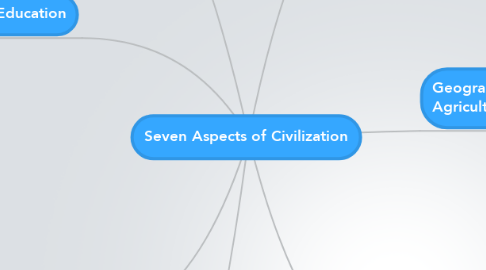
1. Arts and Education
1.1. Indus Valley
1.1.1. Pottery, metal work, jewlery, etc.
1.1.2. First people in the region to master iron working techniques
1.1.3. Historians dated hegings back to about 2500 BC
1.1.4. First developed writing
1.2. Tigris and Euphrates
1.2.1. Cylinder Seals- Small stoned cylinders engraved all around with detailed designs to "sign" documents
1.2.2. Wrote works on law and grammar, literature, stories, poems, and songs.
1.2.3. Arches, ramps, and columns.
1.2.4. Scribes- Men or upper class women
2. Economy and Trade
2.1. Tigris and Euphrates
2.1.1. Bigger city states led to war over land and water.
2.1.2. Traded with people across southwest Asia.
2.1.3. Traded woven textiles, metal, timber, and stone.
2.1.4. Traded goods they produced.
2.2. Indus Valley
2.2.1. Farmed livestock
2.2.2. In cities, many people did pottery, metal work, and jewlery.
2.2.3. They traded goods they produced.
2.2.4. Traded with people across southwest Asia.
3. Science and Technology
3.1. Tigris and Euphrates
3.1.1. Dug out basins to store rainwater
3.1.2. Canals to carry water
3.1.3. Wheels to create pottery and build vechicles
3.1.4. Used bronze
3.2. Indus Valley
3.2.1. Inclosed cities were built
3.2.2. Drew water from community wells
3.2.3. Streets ran into a pattern north, south, east, and west.
3.2.4. Two large ruin cities were found, named Harappa and Mohenjo D'arco.
4. Social Structure and Family Life
4.1. Indus Valley
4.1.1. Overtime divided into 100's of different groups.
4.1.2. Single society- divided into 4 social classes.
4.1.3. Had different assigned jobs so that no one would be doing the same thing, and they could get a variety of work done.
4.1.4. VIllages
4.2. Tigris and Euphrates
4.2.1. Developed a law code
4.2.2. Blended cultures with cultures around them
4.2.3. Men had political power and women were house workers.
4.2.4. Had different assigned jobs so that no one would be doing the same thing, and they could get a variety of work done.
5. Religion
5.1. Indus Valley
5.1.1. Gods controlled all natural forces
5.1.2. Priests offered food and drinks by placing them over a roaring fire. They worked to please Gods.
5.1.3. Prayed to may aspects of single and eternal spirits.
5.1.4. Had sacrifices and chanting of hymns.
5.2. Tigris and Euphrates
5.2.1. Polytheism- Worshiped and believed in many gods.
5.2.2. Gods controlled all natural forces
5.2.3. Worked to please gods. Gods were like humans.
5.2.4. Gods protected each city state.
6. Geography and Agriculture
6.1. Tigris and Euphrates
6.1.1. Grew grains, wheat, and barely
6.1.2. Mesopotamia
6.1.3. Farming and little rain
6.1.4. Swampy and flat land
6.2. Indus Valley
6.2.1. Flows across the Northwest edge of the Indian subcontinent
6.2.2. Soil is very fertile from the river bottoms making plains very fertile
6.2.3. If rain comes too late, people wont be able to grow crops
6.2.4. Three major geographic zones
7. Governments and Leaders
7.1. Tigris and Euphrates
7.1.1. Each city has a city state
7.1.2. Priests governed the city state
7.1.3. Dynasty: Series of rulers from one family
7.1.4. War chiefs began to rule as kings
7.2. Indus Valley
7.2.1. Thrived from 2500 BC-2000 BC
7.2.2. Branims, Ksha Tiyaj, Vaisyas, and Sundras
7.2.3. Each city had a city state
7.2.4. Dynasty: Series of rulers from one family
